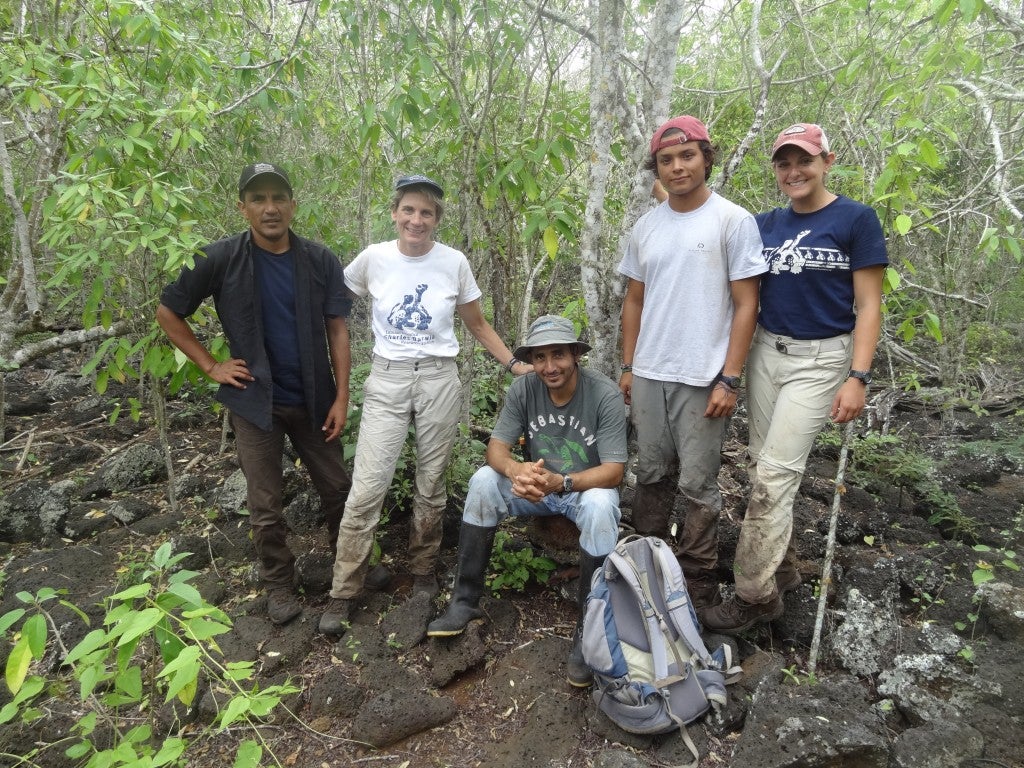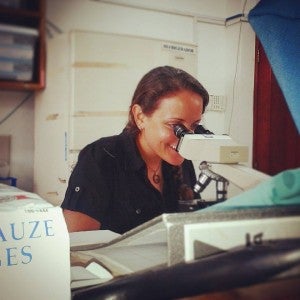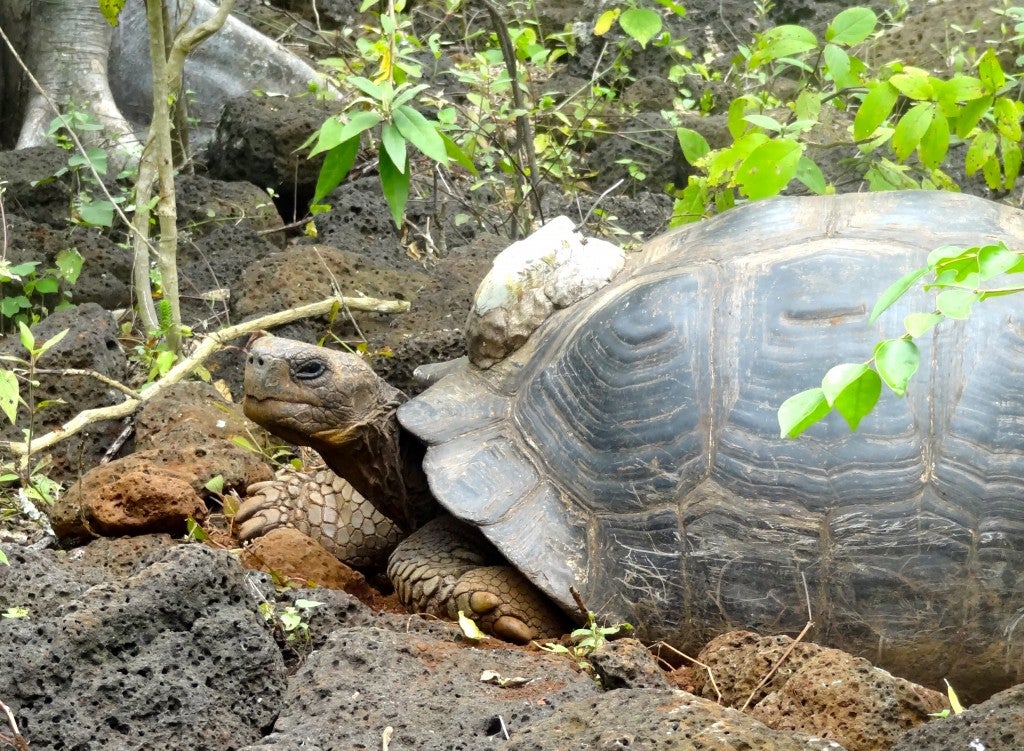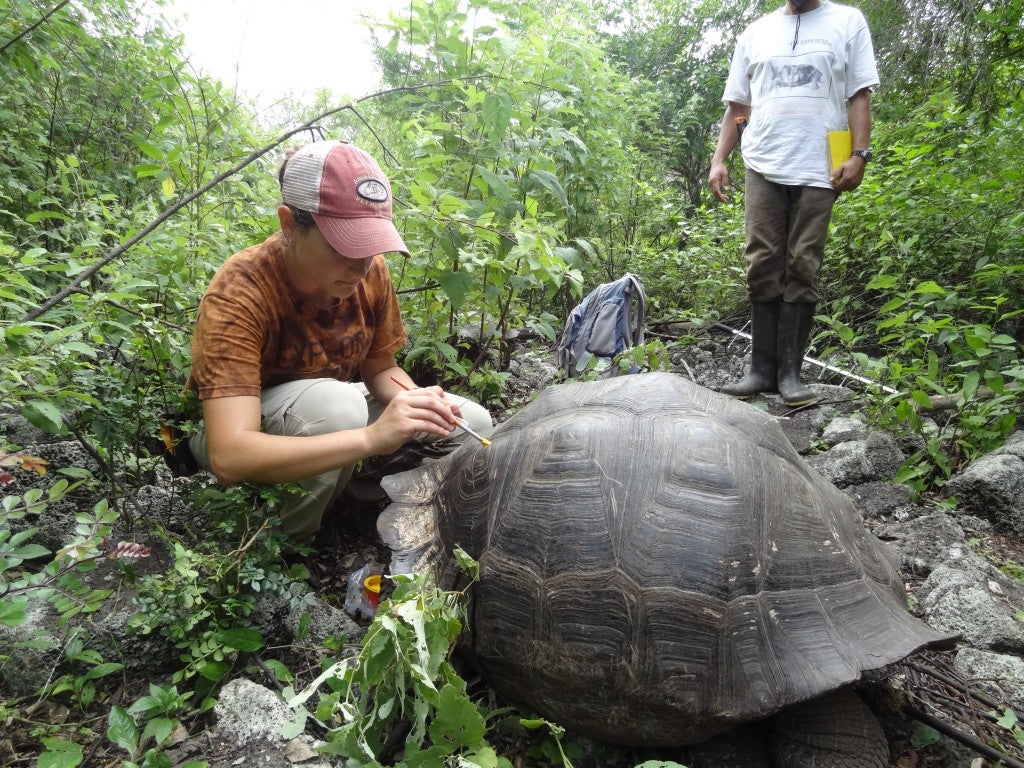Written by Julie Sheldon, Class of 2016

Members of the tortoise tracking team from left to right: Freddy Villamar, Dr. Sharon Deem, Fredy Cabrera, Walter Ernest, and Julie Sheldon. Deem is the director of the Institute for Conservation Medicine at the Saint Louis Zoo and served as PI for the project.
Carefully lumbering over sharp, broken lava underneath my stressed boot soles and anxious ankles, I was disheartened to have obtained blood samples from only two female Galapagos tortoises after hiking for five exhausting hours. The bleeding thorn scratches on my calves craved more data than this! Suddenly, my legs stiffened and my ears perked up before I could register what I had heard. “Sexo…tortugas, allí!” I whispered in my Tarzan-style Spanish to our local tortoise tracker and machete master, Freddy Villamar. I just barely picked up the classic giant tortoise grunt-of-pleasure coming from deep in the trees to my left. If I did the logic, there will be a female, or hembra, with our vocal male, or macho. After maneuvering through cacti, thorns, and wasp nests, intermittently stopping to listen for the next grunt to guide us further, we confronted our romantic couple about 100 yards into the brush. Yeah, more tortoise blood for our research project.
Due to hungry pirates sailing in the Pacific ocean off the coast of Ecuador through the 16-18th centuries, Galapagos giant tortoises were almost hunted to extinction—if you call piling slow, car-sized reptiles into hulls of ships by the hundreds to be stored as food, “hunting”. The Galapagos Tortoise Movement Ecology Programme, in conjunction with the Galapagos National Park, the Charles Darwin Foundation, and the Saint Louis Zoo Institute for Conservation Medicine, is studying the biology, reproduction, migration, and health of these dinosaurs in order to assist with their conservation. The efforts put forth by these organizations has led to population increases from only about 3,000 in the 1970s to approximately 20,000 today!
Last summer, I was lucky enough to set up my STAR (Students Training in Advanced Research) project in the Galapagos Islands with the Galapagos Tortoise Movement Ecology Programme. I compared the different white blood cell counting methods available for reptiles, since the machines we use for mammalian blood do not differentiate nucleated reptile red blood cells from white blood cells, or globulos blancos. Every other day, our team would trek into the field, el campo, and hike for 8-9 hours, covering a distance of about 16 kilometers. Experiencing these unmarked trails, I was able to see the real, natural Galapagos, which made it crystal clear why explorers did not initially settle there when they discovered these enchanted islands centuries ago. The dry, prickly, and ankle-breaking terrain was quite unforgiving, but I was stoked to be hiking through it.
We performed complete health assessments on tortoises including a physical exam, blood and fecal collection, ultrasound, morphometric data collection, and weight measurement. Some days we came across many eager patients enjoying the slight clearing of our trail, but other days we would spend hours tracking a certain tortoise donned with a GPS tag (containing valuable migratory data) via a VHF radio transmitter. Despite the relatively small size of the island, and the relatively enormous size of the tortoises, locating some of them was like looking for a needle in a … cactus forest.
Needless to say, I learned more this summer than I thought possible—from speaking Spanish while immersing into the culture of the Galapagos, to drawing blood from tortoises and differentiating thousands of blood cells. Problem solving in the field became a daily activity. Maintaining a positive attitude with a sense of humor in light of difficulties and unexpected curveballs is something I learned from my mentors this summer that I plan to take with me throughout the rest of my career. Hopefully, one day I will return to my research office of the Galapagos jungle where copulating chelonians can make a day a success!
Many thanks to the Galapagos National Park for permission to perform this study and the Charles Darwin Foundation for logistical support.
About the author: Born and raised in south Florida, Julie Sheldon (Class of 2016) gained a passion for animals by riding and caring for horses. She attended the University of Florida, earned a bachelor’s degree in Animal Science, and became involved in manatee research and caring for captive wildlife. She made the big move to California to attend veterinary school at UC Davis, where she is currently pursuing a career path in zoological medicine. She hopes to work for an institution dedicated to wildlife conservation, welfare of captive wildlife, and public education to instill an appreciation for threatened species.




